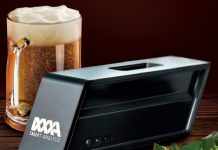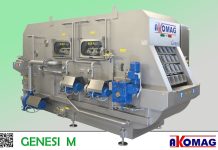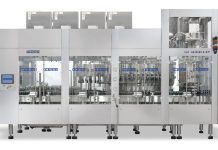 A wine-making system that operates and monitors the entire cellar via PC or tablet, equipped with software-controlled sensors (with auto-adaptive artificial intelligence), adjusts wine-making parameters depending on fermentation, prevents and reports unexpected events which may lead to oenological accidents.
A wine-making system that operates and monitors the entire cellar via PC or tablet, equipped with software-controlled sensors (with auto-adaptive artificial intelligence), adjusts wine-making parameters depending on fermentation, prevents and reports unexpected events which may lead to oenological accidents.
Over the last years, significant progress has been achieved in wine-making management and control. For example, wine-making vats have been developed that are equipped with automatic pumping-over systems and systems for controlling the temperature with the possibility of hot and cold contribution, managed with the support of sensors arranged aboard the vats; these sensors can detect the must density, the developed mass flow of carbon dioxide (CO2), the temperature of the must, etc. Thanks to these systems, the user can monitor the fermentation process and manually adjust the wine-making parameters (including increasing and/or decreasing temperature, adding nutrients, operating pumps and mechanical must mixing actuators, etc.). However, despite the mentioned progress, the wine-making process is far from being optimized, because it is strongly linked to human choices, often based on personal experience and empirical data and not on an analytic, scientific interpretation of chemical/physical data. Especially the most dynamic wine-makers, attentive to final product quality, feel the need to apply efficient wine-making procedures, which are assisted by a scientific and repeatable approach, and in which the result is according to determined targets with regards to the features of the starting material. Furthermore, very important is the need for a more accurate wine-making process control during its execution.
The “Vinifica” Wine-Making System
The object of this automated wine-making system is to solve the aforesaid problems. By means of an appropriately trained neural network, the system processes a collection of historical data concerning passed wine-making processes, scientifically and systematically stored in an appropriate database, in order to obtain, by means of a “data mining” process, an optimal wine-making model. By using an appropriate artificial intelligence unit, the system manages and controls the wine-making process, and is capable of implementing self-adapting and adjusting operations for preventing/avoiding possible fermentation kinetics abnormalities, both automatically and by sending alarms and working orders to the operators.

System Configuration
With reference to fig. 1, the automated wine-making system “Vinifica” comprises (1):
• a wine-making vat (2) suitable to contain a liquid-solid mass (must or crushed grapes);
• sensors (3) operatively coupled to the wine-making tank, adapted to detect specific process parameters (temperature, pressure, flow rate);
• actuators (4) for intervening on the processing of the mixture (including an automatic wine-making robot, an automated wine-making unit, a pumping-over pump with suction pipe, a porous diffuser);
• a control unit (6) coupled to the wine-making vat 2 (e.g. being arranged aboard the vat itself), and operatively coupled both to the sensors (to detect the signals related to the detected quantities concerning the wine-making process), and to the actuators (so as to actuate them on the basis of the data output by the same sensors and appropriate processing (in particular by means of suitable fuzzy logic algorithms), enabling appropriate corrective actions;
• a local processing unit (8) (e.g. laptop computer, tablet or Smart Phone), which communicates and exchanges data with the control unit, via cable or wireless;
• a central processing unit (9) provided with a memory adapted to store a wine-making database (10), storing historical data related to past wine-making processes;
• appropriate communication infrastructures (11) (with wireless, Wi-Fi, Bluetooth, IR, Ethernet and/or Internet technology) to allow data exchange between the control unit aboard the vat, the local processing unit and the central processing unit.
Operation
As grape harvesting approaches, the user of the automated wine-making system will sample the grapes directly at the vineyard according to rules of good wine-making practice to subject them to chemical/physical/sensorial tests, in order to establish the best date for starting harvesting and collect information useful for defining the best wine-making strategy for that particular batch of grapes. Having obtained such data, the user accesses the wine-making database and the program implementing the neural network for extraction of the optimized wine-making models, firstly training the neural network with training sets 8i.e. input/output pairs) already present in the database itself and related to past wine-making processes to be used as reference. At the end of the neural network training procedure, the user enters the new input data obtained from the grapes sampled at the vineyard and the desired wine-making target data. On the basis of the received data, the central processing unit extracts the optimized wine-making model. After having fed the must into the wine-making vat, the control unit aboard the tank actuates the actuators to perform the process steps as contemplated by the optimized wine-making model. During the entire fermentation process, the control unit executes a series of parameter detections by means of the sensors, in order to precisely execute the received wine-making model. The control unit implements also automatic corrective actions, determined by means of fuzzy logic algorithms, to control the fermenting mass, and, where necessary, it sends manual working orders to the user. Furthermore, the systems reports faults (fermentation stops or excessively rapid fermentation kinetics) and/or sends alarm signals or sound indications by means of SMS or other communication means. During the wine-making process, the control unit records all execution data related to this process in a log file. The log file may be integrated by the user by entering additional data concerning the specific wine-making process and the properties of the obtained product (wine).

What is a neural network?
Neural networks are used for processing information and supporting decisions in complex problems. A neural network may be seen as a system capable of providing an answer to a question, answer which is obtained by means of a training process using empirical data. In particular, a neural network is capable of interpolating and extrapolating from the training set data, which in this case are stored in the wine-making database. It is easy to understand that the result produced by a neural network is gradually more accurate the better the training of the same network. The initial content of the wine-making database consists of a library of input/output pairs which refer to wine-making models inferred from researches carried out in some major European countries (including France, Spain, and Italy) over the last ten years. Such data allow to start an initial training of the neural network so as to extract an optimized wine-making model.




